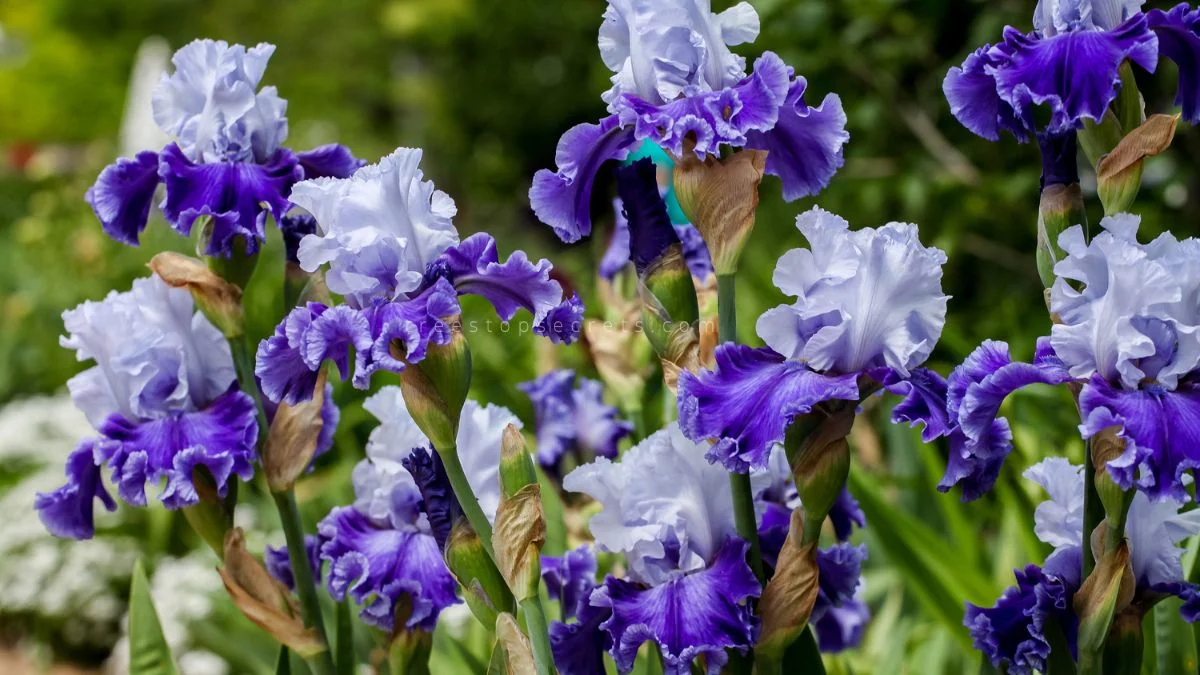Looking to expand your garden with vibrant iris blooms? Dividing iris plants is the key to multiplying their beauty effortlessly. Discover the simple steps and expert tips to divide your iris plants successfully. From enhancing blooming potential to rejuvenating overcrowded plant beds with divisions, dividing iris plants' rhizomes and roots offers a burst of color and vitality to your outdoor space. Are you ready to take your gardening game to the next level by learning how to cut, divide iris plants' rhizomes like a pro?
Key Takeaways
- Recognize When to Divide Irises: Monitor your irises' roots and rhizome for overcrowding or reduced blooming as signs that division is needed.
- Prepare Adequately: Gather necessary tools like a spade and prepare the soil before starting the division process.
- Follow Step-by-Step Division: Divide irises carefully, ensuring each new rhizome has healthy roots and leaves.
- Consider Different Types: Tailor your division technique based on the iris type to promote successful growth.
- Replant Thoughtfully: Plant divided irises at the right depth and spacing to encourage healthy development.
- Provide Proper Aftercare: Water newly divided irises regularly and monitor for any issues to ensure their well-being.
Recognizing the Need to Divide Irises
Signs of Overcrowding
Recognize crowded clumps with reduced blooming. Identify rhizomes pushing out of the ground, indicating overcrowding. Observe stunted growth and smaller flowers due to lack of space.
Reduced Blooming
Understand the link between overcrowding and reduced blooming in irises. Realize how overcrowding impacts flower size and quantity, affecting overall plant health negatively.
Timing for Division
Divide irises after flowering in late summer to ensure successful division. Consider dividing every three to five years for optimal growth. Ensure well-established roots before the first frost hits for better survival rates.
Preparing to Divide Irises

Gathering Tools
To successfully divide iris plants, you will need a spade or garden fork to lift clumps easily. Clean and sharp pruners are essential for trimming leaves without causing damage. Prepare containers to store and transport rhizomes safely.
Choosing the Right Day
Select a cool and cloudy day to minimize stress on the plants during the division process. Avoid dividing irises when it's hot and sunny as this can shock the plants. For optimal results, aim to divide early in the morning or late in the afternoon.
Step-by-Step Division Process
Lifting the Clumps
Using a spade is essential to lift the entire clump of iris plants gently from the ground. Shake off excess soil to reveal the interconnected rhizomes underneath. It's crucial to handle the clumps with care to avoid any damage during the division process.
Separating Rhizomes
When separating the rhizomes, ensure to select those with healthy roots and leaf fans for optimal growth. Discard any old, leafless rhizomes that are no longer productive. Destroy any soft, smelly, or rotting rhizomes to prevent spreading diseases in your garden.
Inspecting for Health
Inspect each rhizome carefully to guarantee its health before replanting. Look for firm, plump rhizomes that indicate robust growth potential. Be vigilant in identifying any signs of disease or pest damage that may affect the newly divided plants.
Special Considerations for Different Types
Bearded Iris Division
When dividing bearded irises, start by removing small rhizomes to ensure optimal growth. Replant only the healthy rhizomes that have one or two leaf fans attached. Ensure to discard any large, old rhizomes that lack leaf fans for better plant development.
Siberian Iris Tips
Siberian irises should be divided with caution to preserve their delicate roots. After division, replant them in well-drained soil that receives full sun exposure. Remember to water the newly planted rhizomes thoroughly to support their establishment.
Pacific Coast Iris Advice
For Pacific Coast irises, divide them right after they finish flowering to promote healthy growth. When selecting a planting location, opt for an area with partial shade and moist soil conditions. To retain moisture levels, consider mulching around the plants regularly.
Replanting Divided Irises

Selecting a Location
When replanting divided irises, choose a sunny area with well-drained soil to ensure optimal growth conditions. Consider the height of the irises as taller varieties should be placed at the back. Ensure good air circulation around the plants to prevent diseases.
Soil Preparation
To prepare the soil for replanting, add organic matter to improve drainage and nutrient retention. Test the soil pH to confirm it is slightly acidic, which irises prefer. Clear the area of weeds and debris to provide a clean environment for new growth.
Planting Depth and Spacing
When planting divided iris rhizomes, position them just below the soil surface to promote healthy root development. Space each rhizome 12 to 24 inches apart to allow room for spreading. Verify the planting depth to prevent rotting and encourage blooming.
Aftercare for Divided Irises
Watering Needs
Water newly planted rhizomes deeply to help them establish in their new location. Ensure the soil is consistently moist during the growing season to promote healthy growth. However, be cautious not to overwater as excessively wet conditions can cause root rot.
Mulching around irises is beneficial as it helps retain moisture in the soil and regulates temperature fluctuations. Apply a layer of mulch around the base of the plants, ensuring it does not touch the rhizomes directly. When fertilizing divided irises, opt for a light application of a balanced fertilizer in early spring to support their growth without overwhelming them.
Mulching and Fertilizing
Mulching around irises is beneficial as it helps retain moisture in the soil and regulates temperature fluctuations. Apply a layer of mulch around the base of the plants, ensuring it does not touch the rhizomes directly. When fertilizing divided irises, opt for a light application of a balanced fertilizer in early spring to support their growth without overwhelming them.
Troubleshooting Common Issues
Pest Problems
Iris plants can face pest issues like iris borers, which harm rhizomes. To combat pests:
- Keep an eye out for iris borers that tunnel into rhizomes.
- Combat aphids and thrips using insecticidal soap.
- Invite beneficial insects, such as ladybugs, for natural pest control.
Disease Prevention
Prevent fungal diseases by taking these precautions:
- Avoid overhead watering to reduce fungal growth.
- Promptly remove infected leaves to prevent disease spread.
- Use fungicides preventatively, especially in humid conditions.
Enhancing Your Garden with Divided Irises
Design Ideas
Plant stunning borders using tall bearded irises to create a focal point in your garden. These irises, with their majestic height and vibrant colors, can add a touch of elegance to any landscape. The verticality of tall bearded irises makes them perfect for creating visual interest and structure in garden beds.
Mix various colors and heights of iris plants to add depth and dimension to your garden. By combining different shades such as deep purples, bright yellows, and soft pinks, you can create a visually appealing display that catches the eye. Varying the heights of the irises within a planting bed adds an element of dynamism to the overall design.
Enhance the beauty of your garden by pairing irises with complementary perennials. Consider planting irises alongside flowers like peonies, daylilies, or roses to create a harmonious blend of colors and textures. The combination of irises with other flowering plants can result in a vibrant and inviting garden space.
Companion Plants
Pair your iris plants with daylilies to ensure continuous blooms throughout the growing season. Daylilies are known for their long blooming period and come in a wide range of colors, making them an excellent companion plant for irises. This pairing guarantees a colorful and lively garden from spring to fall.
Introduce fragrance into your garden by planting catmint or lavender near your iris beds. These aromatic plants not only add a pleasant scent to your outdoor space but also attract pollinators like bees and butterflies. The combination of fragrant herbs with colorful irises creates a sensory-rich environment.
For added texture contrast, consider incorporating ornamental grasses alongside your iris plants. Grasses like fountain grass or blue fescue can provide a soft backdrop that highlights the bold blooms of irises. The juxtaposition of fine-textured grass blades against the broad leaves of irises adds visual interest and diversity to your garden design.
Closing Thoughts
By now, you have gained a comprehensive understanding of how to successfully divide your iris plants. From recognizing the signs that indicate division is necessary to the step-by-step process and aftercare tips, you are well-equipped to ensure the health and vitality of your irises. Remember the special considerations for different iris types and the troubleshooting guide if any issues arise during or after division.
Now is the time to put your newfound knowledge into action. Head out to your garden, identify irises that need dividing, and follow the guidelines outlined here. By taking these steps, you not only enhance the beauty of your garden but also promote the overall well-being of your iris plants. Happy gardening!
Frequently Asked Questions
How do I know when it's time to divide my irises?
Irises should be divided every 3-5 years or when you notice overcrowding, decreased flowering, or a dead center. Dividing helps maintain plant health and promotes better blooming.
What tools do I need to divide irises?
You will need a sharp knife or garden spade for cutting the rhizomes, gardening gloves for protection, and a bucket of water to clean and soak the rhizomes.
Can I divide different types of irises in the same way?
While the general process is similar, specific considerations may vary based on iris types like bearded, Siberian, or Japanese. Adjust your division technique according to the characteristics of each type for optimal results.
How deep should I replant divided irises?
Plant iris rhizomes just below the soil surface with their tops exposed to sunlight. Ensure good drainage and spacing between plants to prevent rotting and promote healthy growth.
What are some common issues I might encounter after dividing my irises?
Issues like root rot, lack of flowering, or pest infestations can occur post-division. Proper aftercare practices such as monitoring moisture levels, providing adequate sunlight, and regular inspection can help address these problems effectively.
Image Source: Paid image from CANVA





